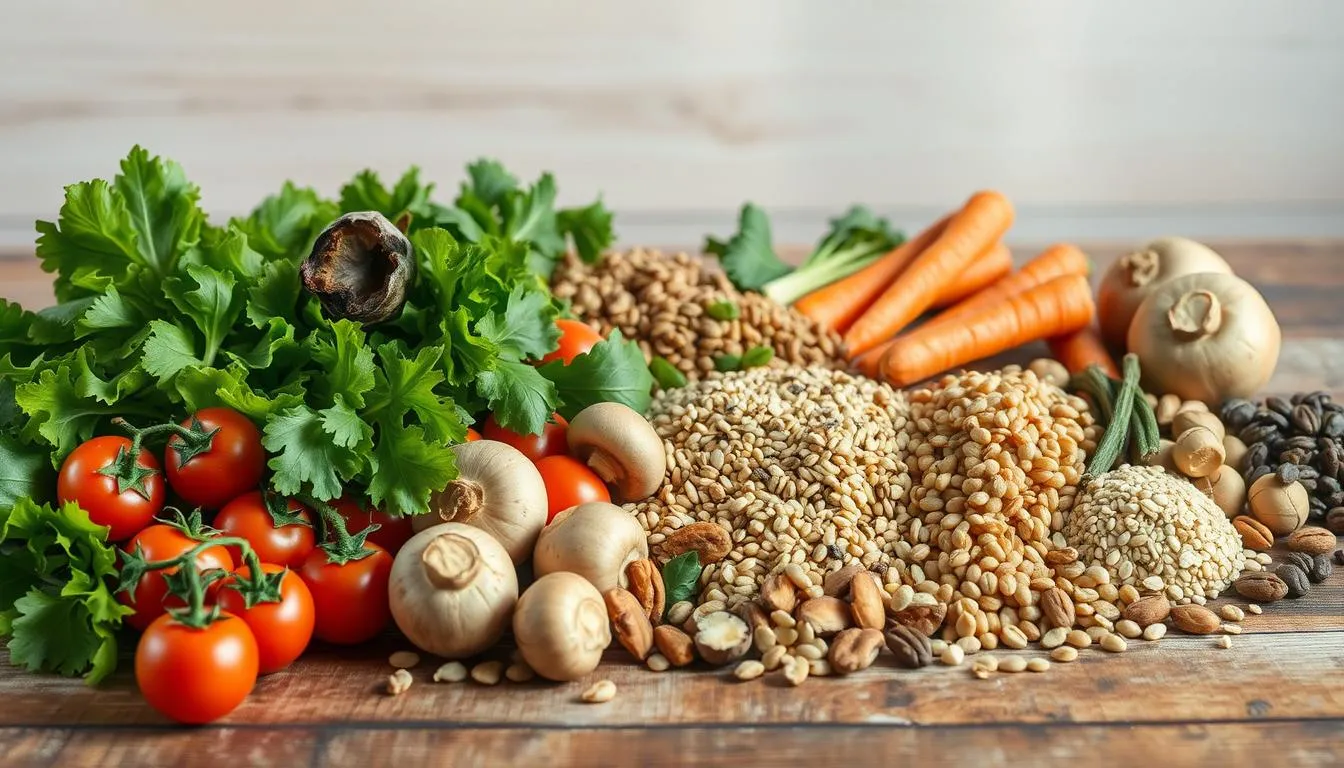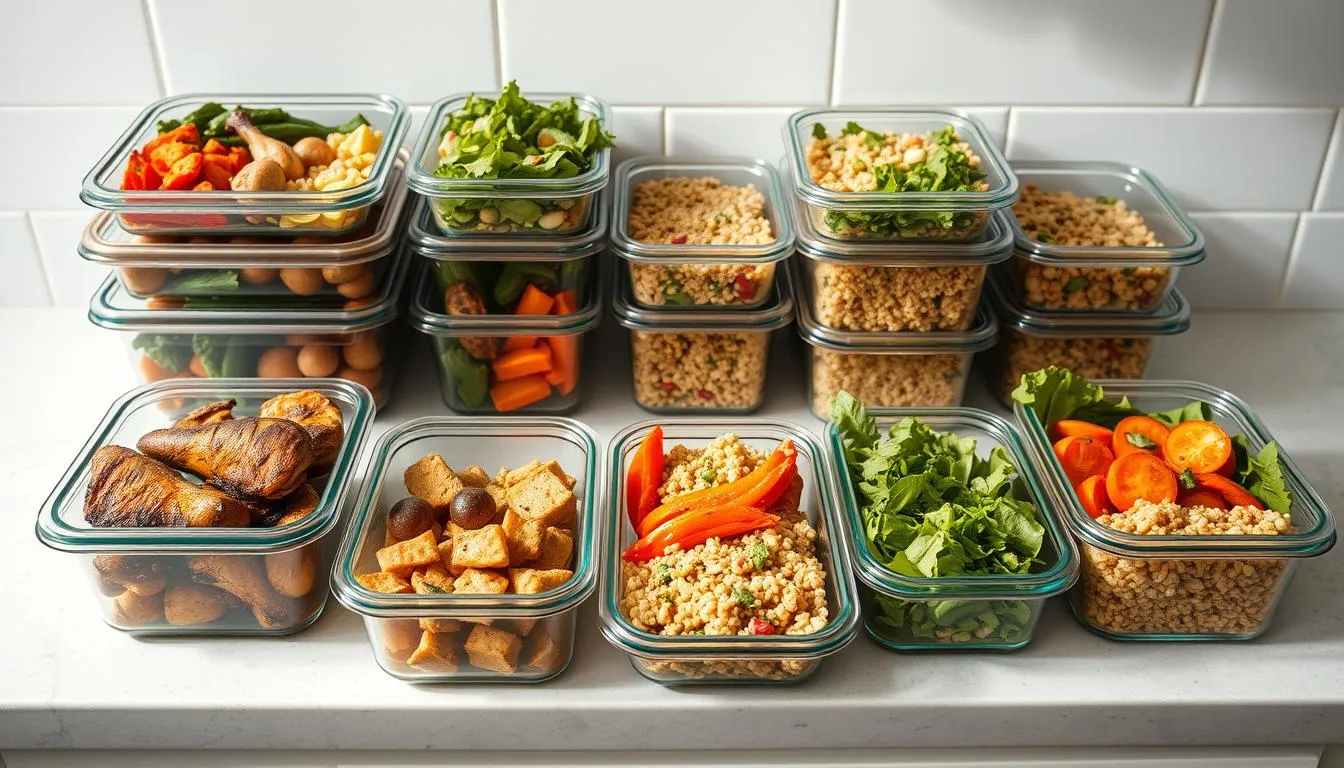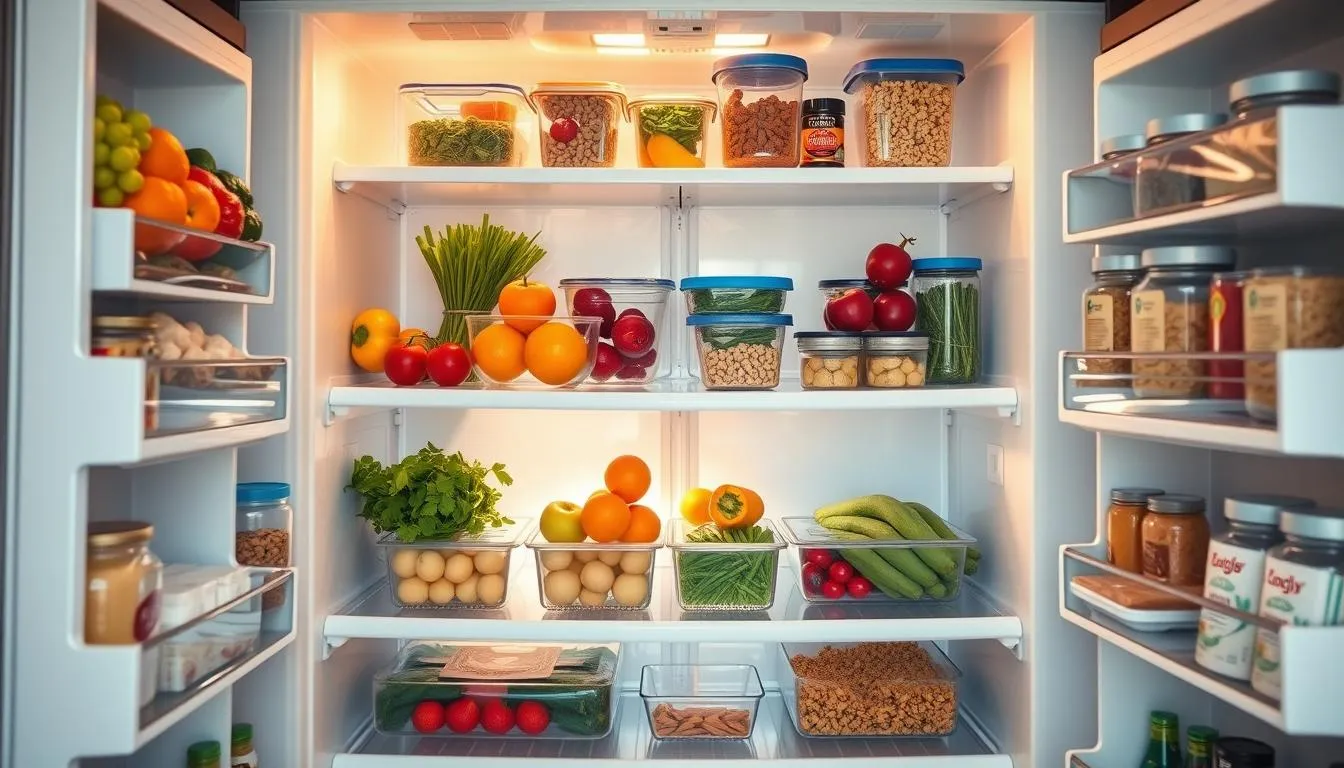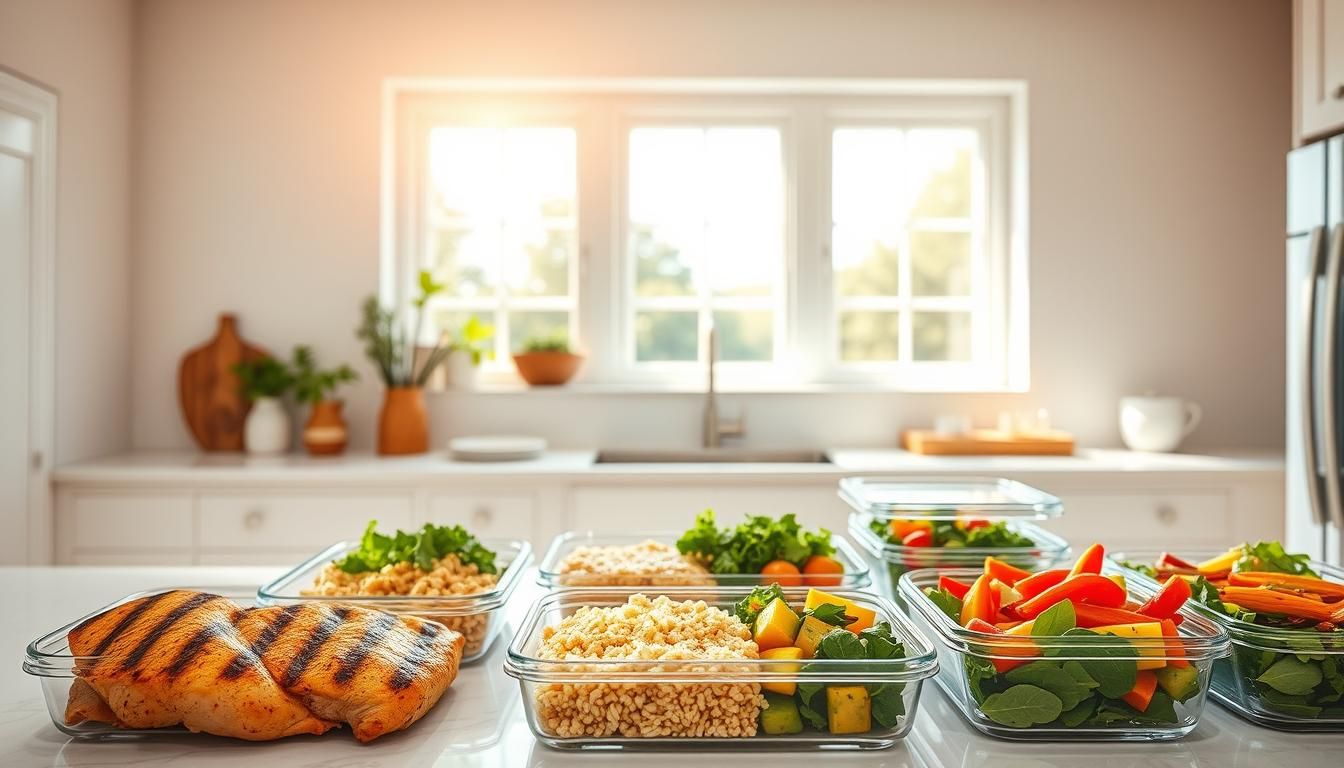Surprising fact: people who plan a week of food in advance reduce takeout costs by up to 30% and eat more vegetables on busy days.
This guide defines smart, real-life choices: focus on whole foods most of the time and save room for favorites so your plan feels sustainable. Aim for an 80/20 balance that keeps nutrition steady without strict rules.
Think of this as a friendly blueprint to make meal prep much easier. You’ll learn how to plan a week, shop with purpose, and store plates so you know what you’re eating and avoid last-minute stress.
Small shifts in your kitchen routine — sharp knives, sheet pans, simple sauces, and clear containers — let you cook once and enjoy variety all week. Optimize post-workout nutrition for recovery nutrition strategies. Enhance your health with immune-supporting exercise routines. Complement your nutrition with a wellness-focused fitness approach. This approach protects your time, budget, and energy while keeping healthy eating doable and flexible.
Key Takeaways
- Adopt an 80/20 approach to make healthy choices last.
- Plan and shop to save money and reduce daily stress.
- Use simple tools to batch-cook and store multiple meals.
- Balance matters; aim for whole grains, lean protein, and veggies.
- Tailor the steps to your life so the routine becomes a habit.
Start Here: How This How-To Guide Makes Healthy Eating Much Easier
Begin with a single hour: a little advance work turns daily cooking into quick assembly. Meal prepping means you cook components in advance so you don’t have to cook every day.
In practical terms, carving out about 60–90 minutes can set you up with breakfasts, lunches, or dinners for several days. This saves time during a busy day and cuts decision fatigue.
Helpful tools speed the process: a sharp chef’s knife, sheet pans, a slow cooker (2.5‑ or 7‑quart), an air fryer, a Dutch oven, and clear airtight glass containers. Plan recipes with crossover ingredients to reduce waste.
- Core process: pick a few simple recipes, shop once, and batch‑cook grains, proteins, and veggies.
- Work smarter: follow an assembly‑line—wash, chop, season, cook, portion—to move quickly through the kitchen.
- Weekly rhythm: schedule one planning day, label containers by day, and organize fridge zones for breakfast, lunch, and dinner.
Do a few things well: batch‑cook quinoa or brown rice, roast proteins, and prep sauces so dinner comes together in minutes. Repeat favorites to keep your routine realistic and sustainable.
Clean Eating, Defined for Real Life
Focus on practical swaps and an 80/20 rhythm that fits a busy life. This approach favors foods in their most natural state and limits highly processed products without adding stress.
The 80/20 way means choose whole foods about 80% of the time and allow favorites the other 20%. That balance helps you stick with healthy eating while still enjoying treats.
Build plates around whole grains like brown rice and quinoa, lean protein, colorful produce, and healthy fats such as extra‑virgin olive oil or avocado. Scan labels to avoid hidden sugars, trans fats, and long ingredient lists.

The smart swaps that upgrade everyday recipes
Simple swaps improve flavor and nutrition with little effort. Try Greek yogurt instead of sour cream, mashed avocado or hummus for mayo, and coconut aminos in place of soy sauce.
- Use honey or maple syrup instead of refined sugar.
- Swap cauliflower rice for white rice and chickpea pasta for regular pasta.
- Keep pantry staples—grains, beans, nuts—to mix into bowls, salads, and quick skillets.
Start small: change one ingredient per recipe and notice how your week of eating becomes simpler and more satisfying.
Clean‑Eating Meal Prep Hacks
Plan once, then mix and match a few cooked components to create fresh plates all week. Map recipes that share grains, roasted veggies, and a couple of proteins so one session fuels many meals.

Plan once, eat well all week: map meals and crossover ingredients
Map your menu for the week so a single batch of roasted vegetables or cooked grains serves multiple dishes. Choose recipes with shared produce and spices to cut waste and shopping time.
Keep it simple: 3-5 ingredient recipes and repeatable meals
Pick 3–5 ingredient dishes and repeat favorites. Repeating reduces decisions and helps you assemble lunches or dinners in minutes.
Assembly-line batching to save time on chopping, cooking, and cleanup
Wash, chop, and season everything at once. Use all burners and both oven racks to cook components in parallel and save time.
Timing matters: what to eat early in the week vs. later
Use tender greens and berries early. Keep kale, carrots, and roasted roots for later. Store dressings separately and add sliced avocado or apple right before you eat to keep textures fresh throughout week.
| Component | When to Cook | Storage | Quick Tip |
|---|---|---|---|
| Grains (quinoa, rice) | Sunday | Fridge 4–5 days | Portion by day |
| Roasted Veggies | Sunday (use both racks) | Fridge 3–4 days | Reheat on high oven for 5–7 minutes |
| Proteins (chicken, beans) | Batch-cook | Fridge/freezer | Slice before serving |
| Sauces & Dressings | Make ahead | Jar, keep separate | Use 2–3 flavors to vary plates |
Pantry, Fridge, and Freezer Setup That Saves Time
A well-stocked pantry and a tidy cold storage system cut weekday cook time in half. Start with a short list of staples and a simple zone plan so you spend less time deciding and more time eating what you planned.

Stock the essentials: grains, proteins, veggies, and clean condiments
Keep whole grains like brown rice, quinoa, and oats on hand. Add lean proteins—eggs, chicken, canned beans—and flavor boosters such as vinegars and mustard. These ingredients make assembling a balanced meal fast.
Organize for speed: clear containers, labels, and shelf zones
Use clear, airtight glass containers and label each with contents and date. Dedicate fridge shelves to breakfast, lunch, and dinner so choices are obvious. Avoid single-use plastic when possible to protect flavor and reduce waste.
Your freezer is your friend: big-batch soups, grains, and cooked proteins
Treat the freezer as a safety net: freeze big-batch soups, cooked meats (2–6 months), and portioned grains. Frozen vegetables are often picked at peak ripeness and remain nutrient-dense food for busy weeks.
- Freeze herbs and sauces in ice cube trays for quick flavor boosts.
- Portion grains and proteins so reheating becomes assembly time, not cooking time.
- Keep a running list of low-stock ingredients and do a weekly fridge and freezer reset.
One-Pan, Slow Cooker, and Air Fryer Meals for Stress-Free Cooking
Use simple appliance workflows to get juicy proteins, tender vegetables, and easy grain sides with minimal cleanup. These methods cut active cooking time and make portions easy to store for the week.
Sheet pan dinners with veggies, chicken, and whole grains
Rely on sheet pan dinners to roast chicken and mixed vegetables together while you warm a tray of whole grains on the lower rack. This approach reduces dishes and lets you batch‑roast using the oven efficiently.
Set it and forget it: slow cooker chilis and stews for the week
Slow cookers are ideal for hands-off chilis and stews. A 7‑quart unit can yield up to ~10 meals, perfect for portioning into lunches and dinners. Try a Tuscan sausage and kale-style stew or a simple bean chili and season spare portions differently to vary the week.
Air fryer veggies and proteins in minutes
Turn to an air fryer when you need crisp vegetables and protein fast. In just a few minutes you get roasted texture without the oven’s wait time.
- Rotate favorites like sheet pan Greek chicken or a 30‑minute chicken skillet to keep variety with minimal prep.
- Combine pre‑cooked grains with a fresh pan or air‑fried vegetables for near‑instant plates.
- Portion dishes right after cooking so they cool quickly and store safely for grab-and-go use.
- Track cook times for each device to hit tender vegetables and juicy chicken consistently.
For more quick air fryer ideas and recipes, check this 30‑air‑fryer recipe collection to expand your rotation.
Prep Once, Eat All Day: Breakfast, Lunch, and Dinner Ideas
Start the week with a simple plan so every breakfast, lunch, and dinner feels fast and fresh. Batch-cook a few bases and combine them in different formats to keep variety without extra work.
Breakfasts to batch and grab
Make mornings easy. Cook Instant Pot steel-cut oats and portion into jars. Bake egg bites or a slow cooker casserole for protein-forward starts.
Yogurt parfaits layered with fruit and granola are quick to assemble and travel well. Try carrot cake oatmeal cups or two-ingredient banana egg pancakes for variety.
Lunches that travel well
Assemble mason jar salads with dressing on the bottom, sturdy ingredients next, and greens on top for crisp lunches all week. Grain bowls with brown rice, beans, and a quality protein like chicken or eggs make satisfying midday plates.
Portion soups or stews into jars so reheating is instant and portable.
Dinners that come together fast
Rotate two dependable dinner recipes: a 30-minute Italian chicken skillet and a sheet-pan pesto chicken with roasted vegetables. Keep a stir-fry recipe on hand to use leftover veggies and cooked rice or grains.
- Batch breakfasts: steel-cut oats, egg bites, yogurt parfaits.
- Pack lunches: mason jar salad, grain bowl, soup jar.
- Fast dinners: skillet chicken, sheet-pan pesto, cashew stir-fry.
Quick tip: Keep a couple of jarred salads and two dinner portions ready in the fridge so you always have meals when the week gets busy. Add high-protein snacks like Greek yogurt with berries to fill gaps.
Flavor First: Sauces, Dressings, and Spice Blends
A few bold sauces and fresh spice mixes turn the same batch of cooked ingredients into weeknight winners. Making dressings, marinades, and dips at home gives you control over ingredients and flavor. They store well and stretch a modest shopping list into many tasty meals.
Make-ahead dressings and hummus keep for days in the fridge. Whisk vinegars, citrus, olive oil, and mustard for a quick vinaigrette. Blend chickpeas, white beans, or roasted beets into hummus to top bowls, spreads for wraps, or a salad boost.
Spice it up with herbs and blends
Stock a core spice lineup—garlic powder, cumin, chili, curry, basil—and rotate combinations. Roast vegetables with one blend and sauté another batch with herbs. This gives the same vegetables a different personality.
- Portion sauces into small jars or ice cube trays for easy use.
- Keep two or three core sauces—herb pesto, tangy vinaigrette, spicy tahini—to transform proteins and veggies.
- Always taste and tweak acid, salt, and heat so flavors pop without heavy additives.
“A simple sauce can change leftovers into a new dish.”
Quick reference tip: write your favorite ratios on a card so you can repeat a reliable recipe without measuring. For more ideas on quick, quality store options to complement homemade sauces, see store-bought sauces and dressings.
Smart Storage, Safety, and Tools to Level Up Meal Prepping
Smart storage choices save time and reduce waste so you get more from every cook session. Use clear, airtight containers and a few simple rules to make leftovers last and stay tasty.
Glass over plastic: airtight, clear, and freezer-safe
Choose glass over plastic for airtight, freezer-safe storage that shows you what’s inside at a glance. Glass keeps food fresher and avoids staining or odors that some plastic products can trap.
Date, rotate, and portion: fridge-to-freezer best practices
Label every container with the cook date and an eat-by date. Rotate older items forward so nothing gets lost at the back of the fridge or freezer.
Safety windows matter: cooked meats generally freeze well for ~2–6 months and soups for about ~3 months. Portion into single-serve containers to cool quickly and save time when you reheat.
Helpful gear: sharp knives, Dutch oven, slow cooker, and containers
Equip your kitchen with a sharp chef’s knife, a Dutch oven for soups and chilis, a slow cooker for hands-off batches, and sturdy glass containers for storage. Freeze herbs, broths, and sauces in ice cube trays to add flavor fast.
- Set fridge shelf zones for breakfast, lunch, and dinner to cut decision time.
- Keep a short freezer inventory so you use items before they expire and avoid duplicate products.
- Cool hot dishes before sealing to prevent condensation, then store promptly.
- End each session with a cleanup routine—wash, dry, and restock—so your next advance session starts smoothly.
“Label, rotate, and portion—those three steps protect flavor and save time.”
Conclusion
Wrap up your week with a simple rhythm that keeps good food within easy reach.
Plan, shop, batch-cook, and portion so healthy eating feels much easier each day. Lean on one‑pan, slow‑cooker, and air fryer methods to save time and turn grains like quinoa or rice into fast bowls.
Use the freezer and labeled containers to stretch cooked dishes across busy days. Rotate a few favorite recipes and repeat what works so you’re eating well without extra decisions.
Remember: aim for progress, not perfection. When you like what you’re eating, consistency follows and your week gets simpler, one small win at a time.
FAQ
What basic tools do I need to get started with weekly meal planning?
At minimum, you’ll want a set of sharp knives, cutting boards, a heavy skillet, a Dutch oven or slow cooker, and a reliable sheet pan. Add airtight glass containers, a measuring cup set, and a digital scale for accurate portions. An air fryer and rice cooker are optional but speed up cooking and reduce cleanup.
How do I plan meals so ingredients crossover and nothing goes to waste?
Start by choosing a few proteins, 2–3 grains, and 4–6 vegetables for the week. Map breakfasts, lunches, and dinners around those items so you reuse roasted chicken in salads, bowls, and quesadillas. Make a simple shopping list grouped by fridge, freezer, and pantry to avoid overbuying.
Can I prepare breakfasts ahead without losing freshness?
Yes. Make steel-cut oats in bulk and portion into jars, assemble yogurt parfaits the night before (keep granola separate), or bake egg bites in a muffin tin and refrigerate. Freeze individual portions of cooked steel-cut oats and reheat with a splash of milk or water.
What’s the best way to store cooked grains and proteins to last the week?
Cool foods quickly, then store in shallow, airtight glass containers. Cooked grains like quinoa or rice keep 4–5 days in the fridge; proteins such as roasted chicken or tofu last 3–4 days. For longer storage, freeze in portioned containers for up to 3 months.
How can I make salads stay crisp when prepped in advance?
Layer ingredients in mason jars with dressing at the bottom, sturdier veggies next, and leafy greens on top. Keep crunchy toppings like seeds or croutons separate. Dress just before eating to maintain texture and flavor.
What are quick, healthy ideas for dinner on a busy weeknight?
Sheet pan dinners with seasoned chicken or salmon and veg take 25–35 minutes. Stir-fries use pre-cooked grains and frozen vegetables for a 15–20 minute meal. Air fryer proteins and roasted sweet potatoes are fast and low-effort.
How do I safely reheat food from the fridge or freezer?
Reheat grains and proteins until steaming hot in a skillet, oven, or microwave. Thaw frozen items overnight in the fridge or use a microwave’s defrost setting. Never refreeze food that’s been fully thawed unless it was cooked again.
What smart swaps make everyday dishes more nutritious without extra time?
Swap white rice for quinoa or farro, use Greek yogurt instead of sour cream, and replace sugary condiments with mustard or homemade vinaigrette. Add frozen spinach or mixed vegetables to sauces and soups to boost fiber and vitamins.
How can I add variety to weekly menus without complicating prep?
Use versatile sauces and spice blends to change flavors—think chimichurri, tahini dressing, or a curry paste. Rotate a handful of herbs and two spice mixes each week and use them across proteins, grains, and roasted vegetables.
What are the best freezer-friendly meals to batch cook?
Soups, stews, chilis, cooked grains, lasagna, and cooked proteins like pulled chicken or turkey meatballs freeze well. Portion into meal-sized containers, label with the date, and freeze for up to three months for quick weeknight dinners.
How many recipes should I plan for one week to keep things simple?
Aim for 6–8 core recipes that reuse ingredients. For example: two breakfasts, three lunches, and three dinners that share proteins and grains. Repeat favorites so shopping and prep stay efficient while still avoiding boredom.
Are plastic containers okay, or should I use glass only?
Glass is better for reheating and long-term storage because it won’t stain or leach chemicals. BPA-free plastic is fine for short-term use or lunches, but choose freezer-safe, airtight options and avoid heating food in plastic when possible.
How do I keep food safe when packing lunches for the workday?
Pack perishable items in insulated lunch bags with an ice pack. Use leakproof containers for dressings and sauces. Keep prepared salads and dairy-based dishes chilled until mealtime and consume within 4–6 hours if not refrigerated.
What’s a simple weekly workflow to save time in the kitchen?
Spend 60–90 minutes on a single prep day: roast vegetables, cook grains, portion proteins, and make a sauce or dressing. Store everything in labeled containers so assembly takes 5–10 minutes per meal during the week.
How can I meal plan on a tight budget?
Base menus on affordable staples like oats, rice, beans, eggs, and seasonal vegetables. Buy proteins in bulk, use frozen produce, and plan flexible recipes that accept different vegetables or grains. Track prices and shop sales for pantry restocks.
What’s the easiest way to track freshness and rotate foods?
Label containers with the cook date and use the FIFO method: first in, first out. Store older items at the front of the fridge or freezer. Keep a visible list of prepared items so nothing gets overlooked midweek.
